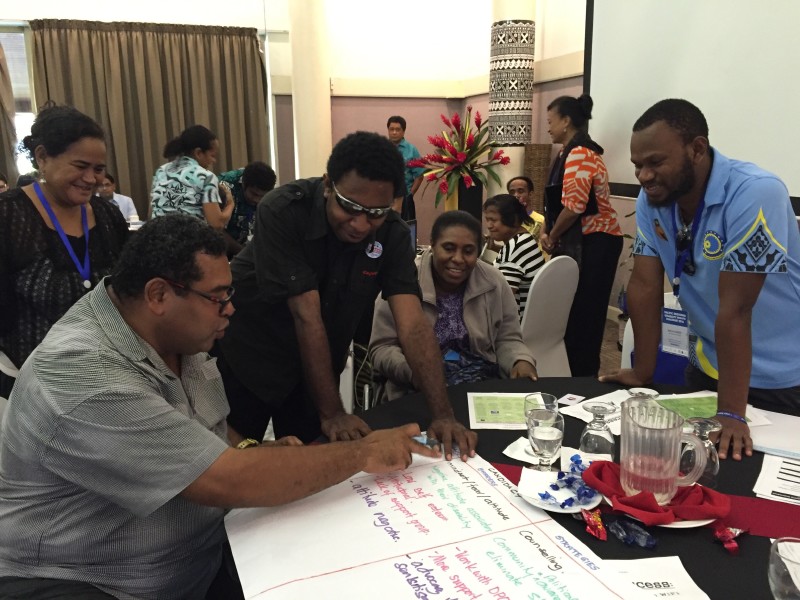What are the barriers to disability inclusion in rural and remote communities?
The barriers that persons with disabilities experience in urban areas are magnified in a rural or remote setting.
Stereotypes and stigma
One key barrier to rights in rural and remote areas is discrimination. In places that are geographically distant from educational and other opportunities, persons with disabilities may encounter stigma as a result of community members’ lack of interaction with persons with disabilities. There may be misinformation about disability. As Bani Alfred of Disability Promotion and Advocacy Association in Vanuatu described, “[Persons with disabilities] are being looked down [on] as someone who is not able to do something or just can’t do it. Persons with disabilities are left behind and not [given] a chance to enjoy their human rights as other people in the community.”
Lack of awareness and services
Persons with disabilities may not know about the services that are available to them. Programs and other services designed to support persons with disabilities, whether through government agencies or aid from other entities, are largely concentrated in cities, towns and other urban areas. According to one Fijian with a disability, what few services exist in rural areas may follow the charity model often used by nongovernmental organizations that are implementing projects, rather than the social model or human rights perspective.
Lack of data
Researchers already face challenges with collecting accurate data even among people with disabilities in urban areas–for example, how to capture people who do not self-identify as having a disability. These existing challenges are compounded when attempting to include people in rural areas. Data collection methods frequently do not account for the challenges of reaching and counting people who live in rural and remote areas. Poorly maintained infrastructure in remote areas and other issues can prevent researchers from collecting samples in rural communities. These difficulties can result in inaccurate data.
Inaccessible transportation
Rural areas often have fewer transportation options, and in many countries, roads and other infrastructure are not as well maintained as they are in urban areas. This can make it more difficult for persons with disabilities to take part in community life. Their absence from most community activities, and their resulting invisibility in society, reinforces the assumptions and stereotypes that others make about people with disabilities.
How can these barriers be addressed?
Although it is important to recognize that these barriers exist, it is even more critical to begin working to change structures that restrict access to rights.
Training and awareness campaigns
Many of the barriers that people in the Pacific Islands region encounter result from a lack of information about disability, available services, and their rights. When people with disabilities provide training in rural and remote areas about disability rights, this not only expands the reach of information to people who are more likely to be marginalized from services but also serves as an opportunity for leadership within the community.
Improve reach of services
When international organizations and governments design interventions, it is important that they take into account which groups of persons with disabilities will be reached. Through advocacy, disabled people’s organizations (DPOs) can affect which communities are served through these interventions.
Learn from good practices
Sharing experiences in rural and remote areas is critical for ensuring that people who are marginalized, not only because of their disability status but also because of factors such as geographic isolation, have access to advocacy tools. People with disabilities living in these communities share common challenges, and targeting remote communities may help to break down communication barriers that restrict their ability to transfer knowledge.
Political Participation in the Pacific Islands Region
During the 2016 Pacific Regional Disability Rights Dialogue organized by the International Foundation for Electoral Systems (IFES) and the Pacific Disability Forum (PDF), advocates from around the Pacific Islands region noted that rural and remote communities face additional challenges to voting in elections and participating in political life.
Ruci Senikula, secretary of the United Blind Persons of Fiji, described how barriers in these communities restrict integration of persons with disabilities into political life:
“Elections for persons with disabilities living in the rural areas in Fiji has a lot of challenges. Women with disabilities face barriers in accessing their rights to vote as many a times, the voting venue is either not accessible or too far from their homes, therefore, not allowing them to exercise their rights. In the outer islands, sign language services are not provided and in the case where deaf voters wish to take someone whom they know and trust to help them cast their votes, this is strictly forbidden.”


